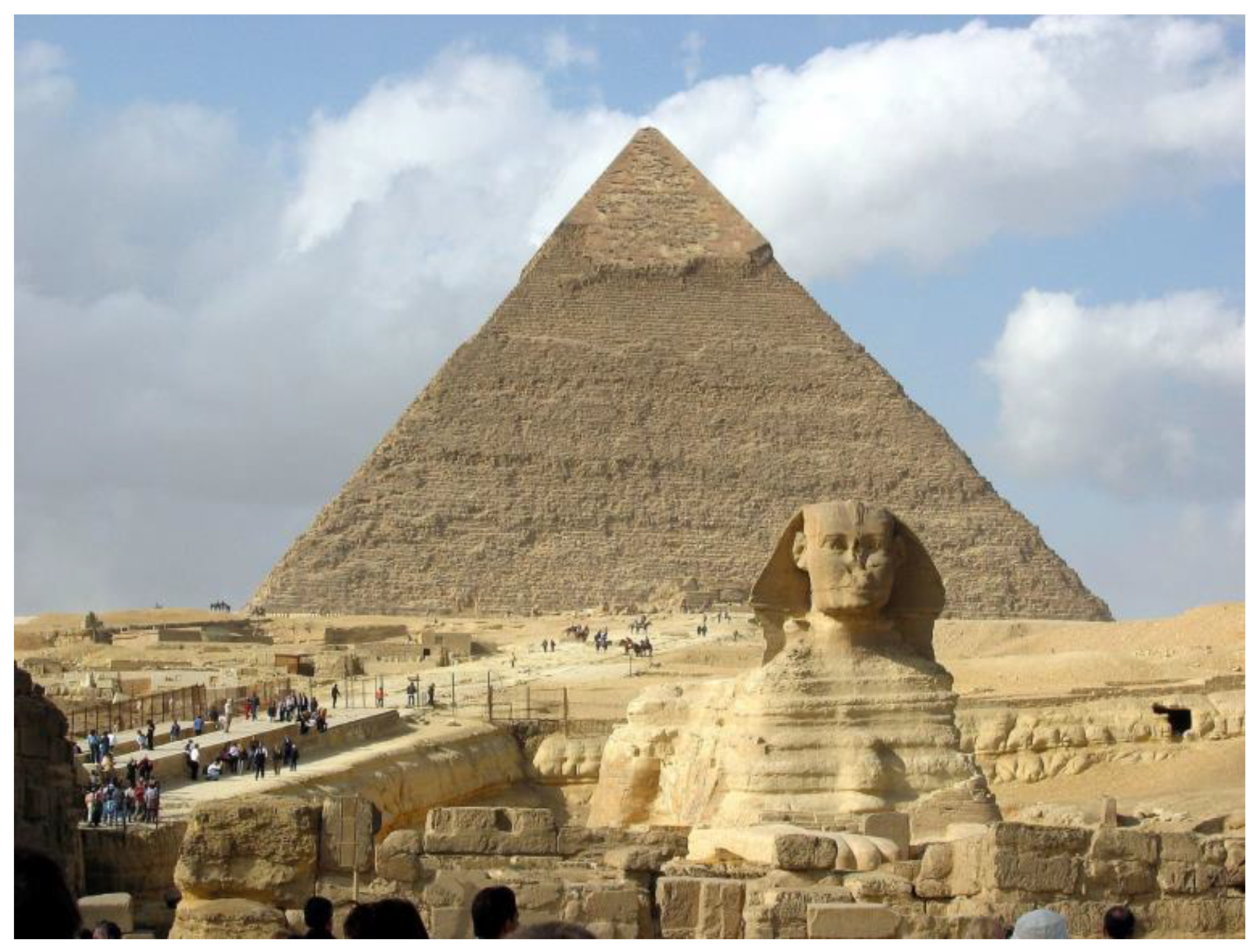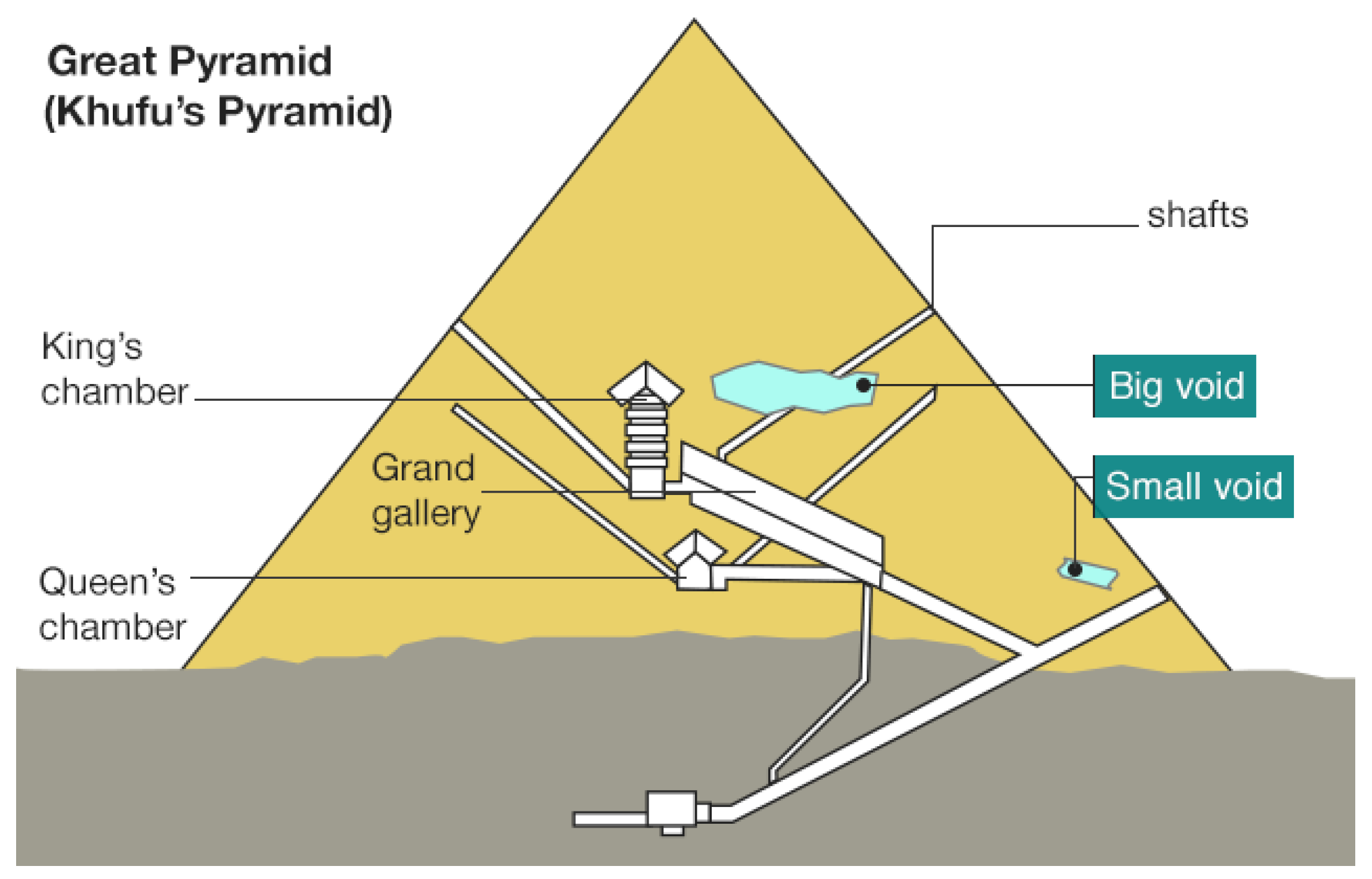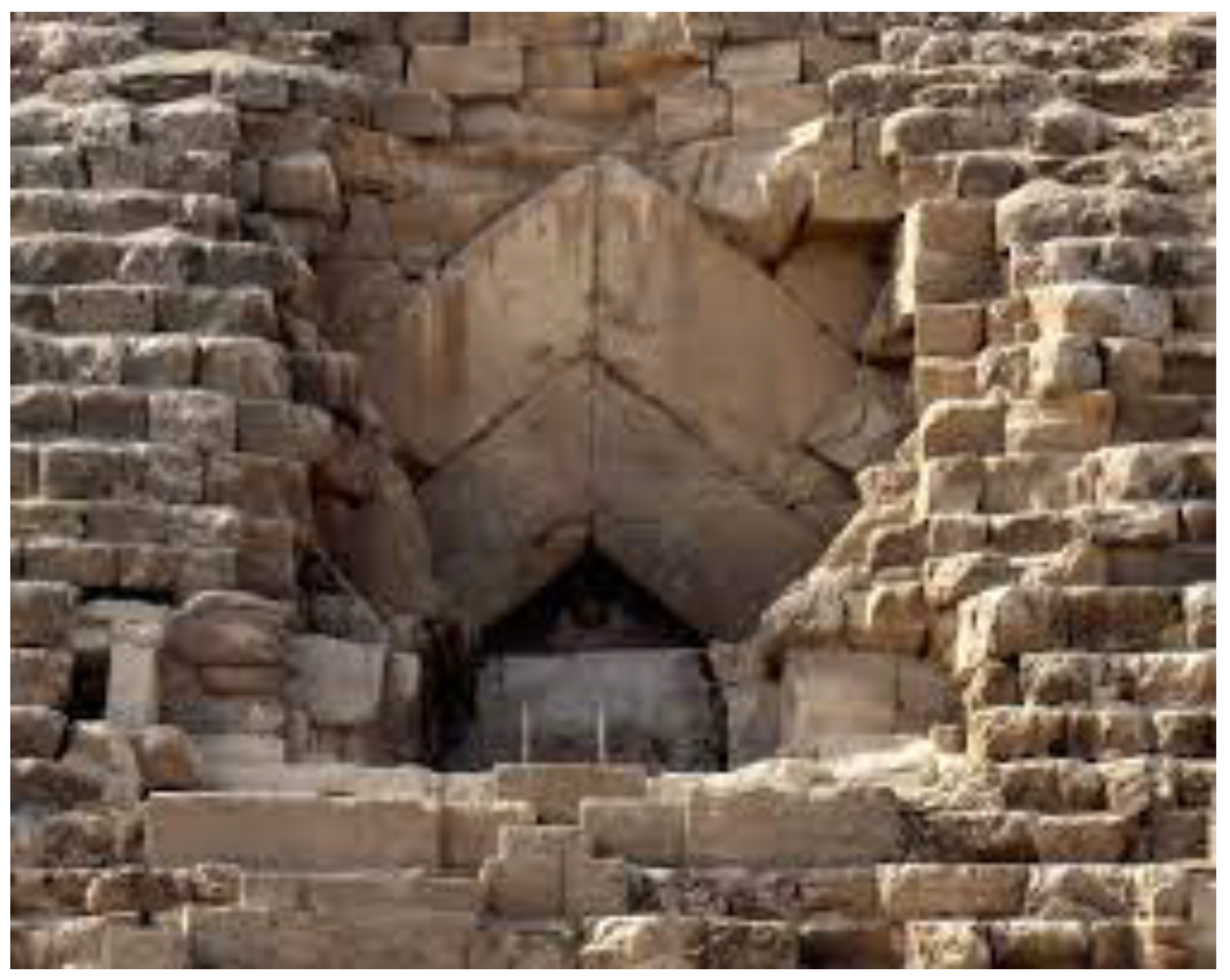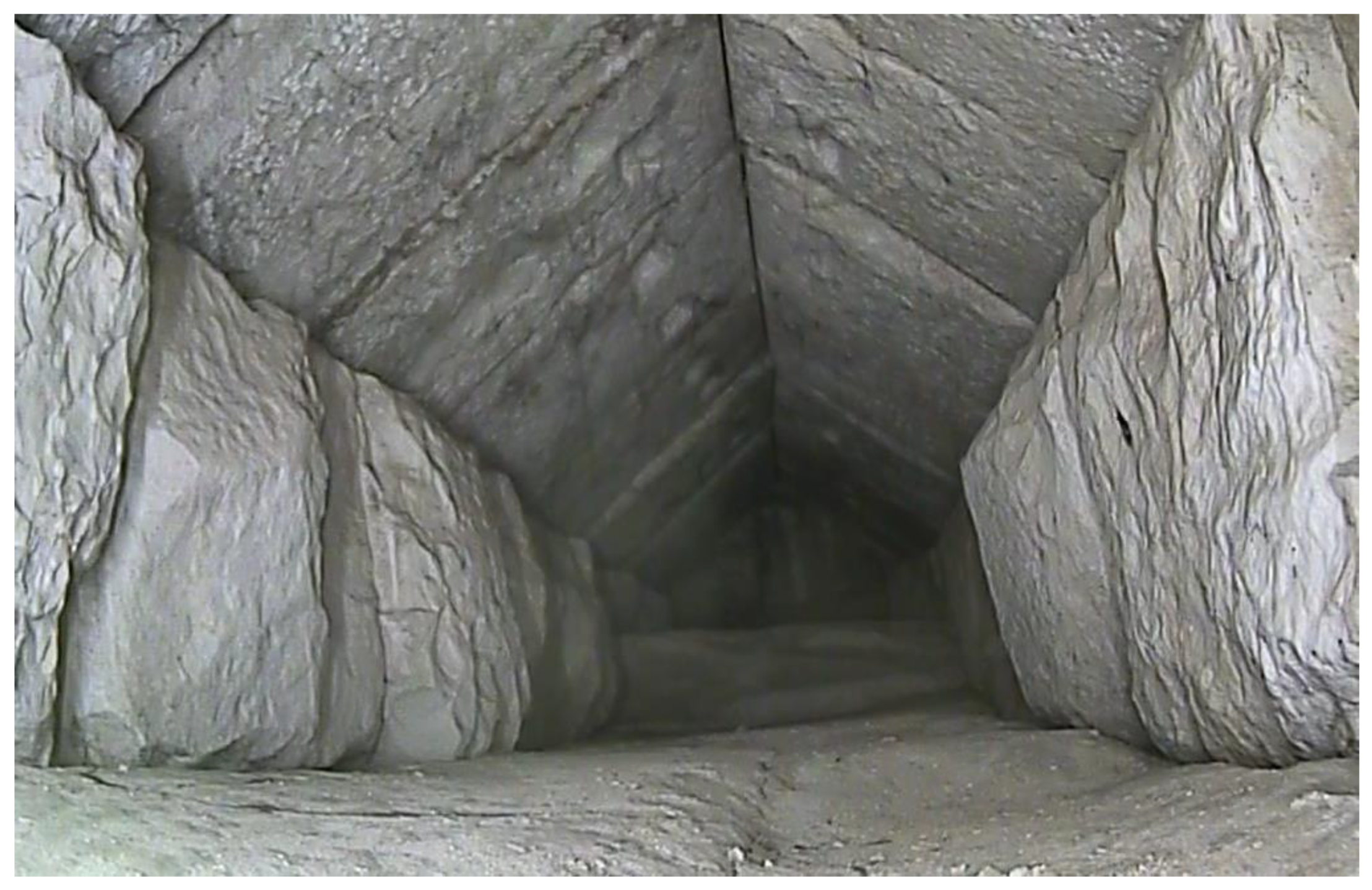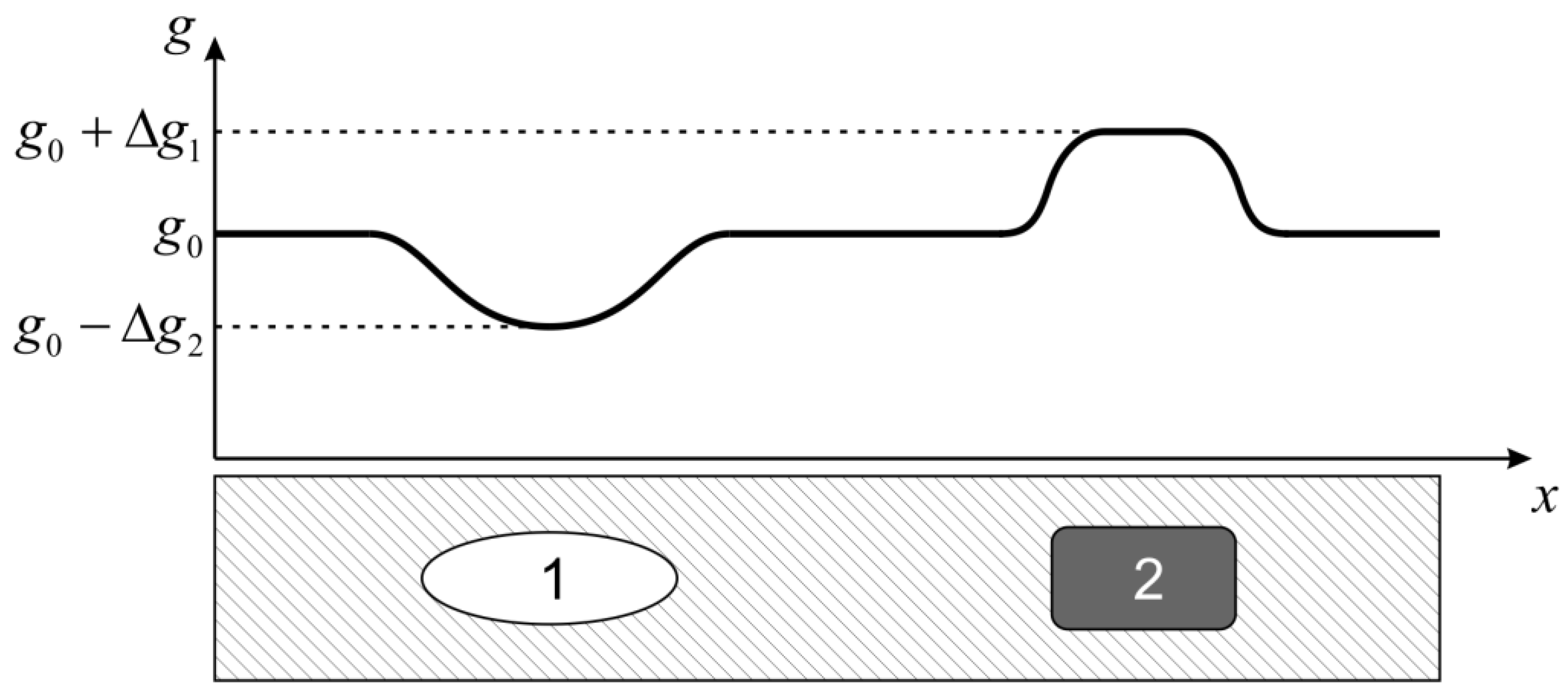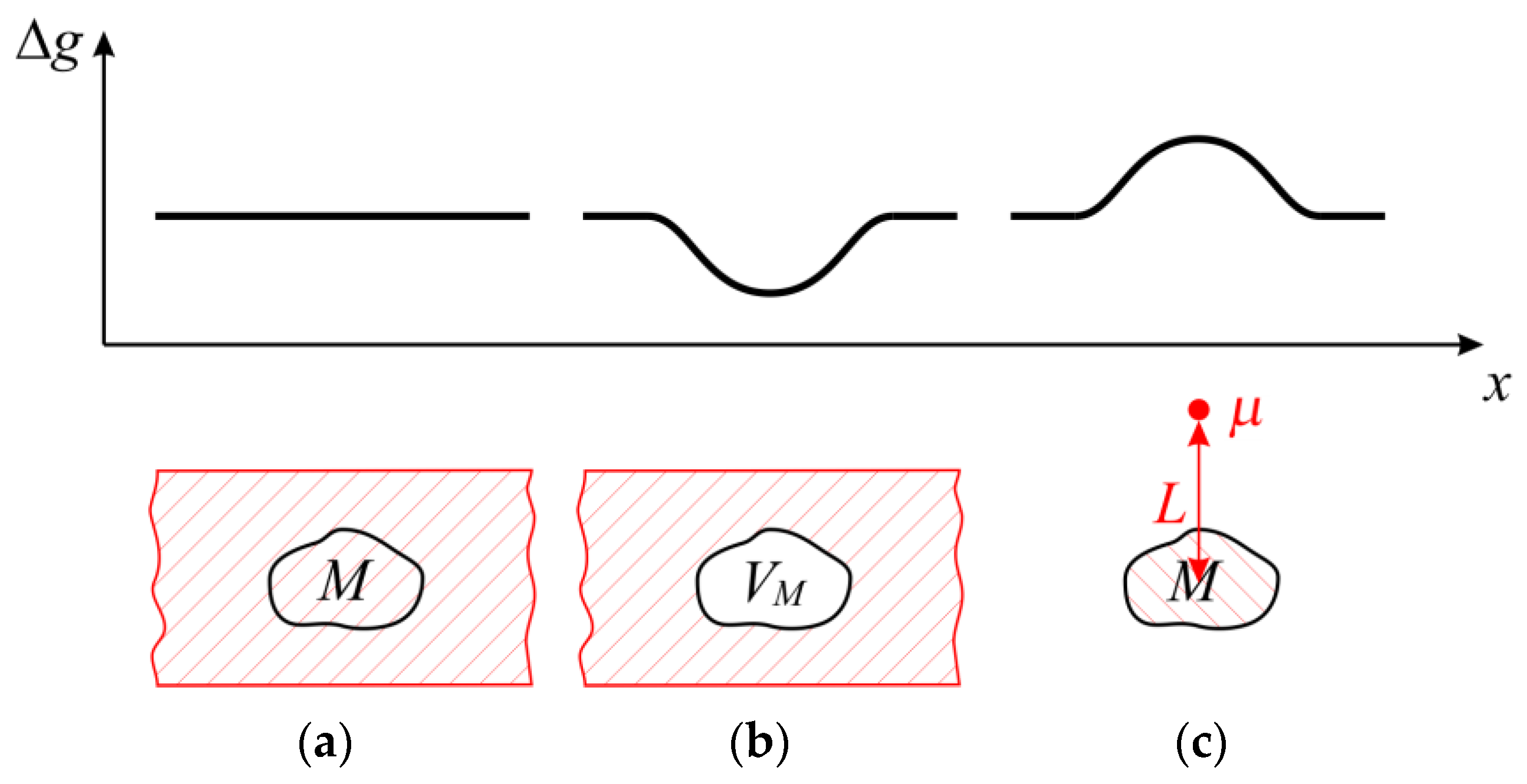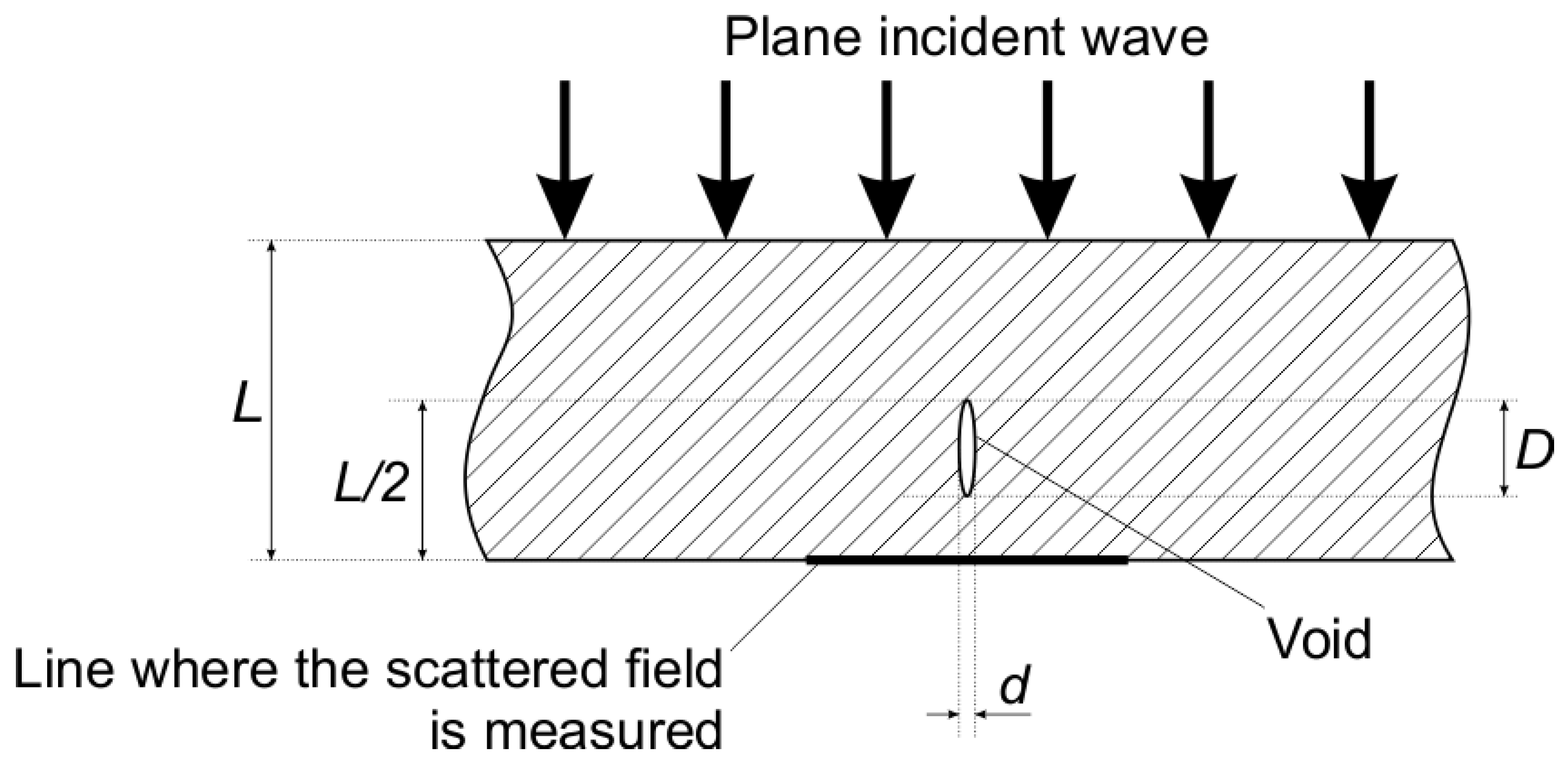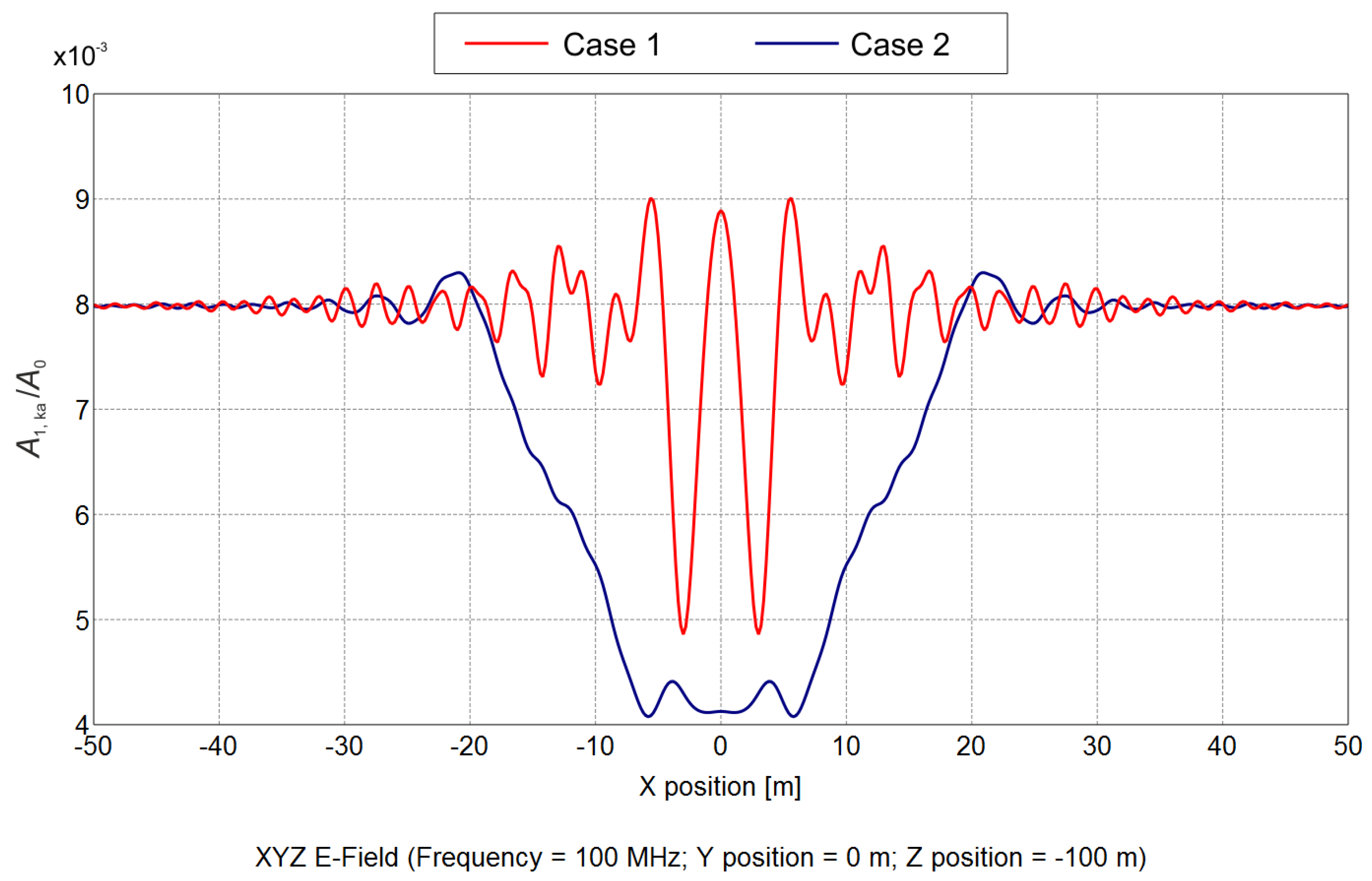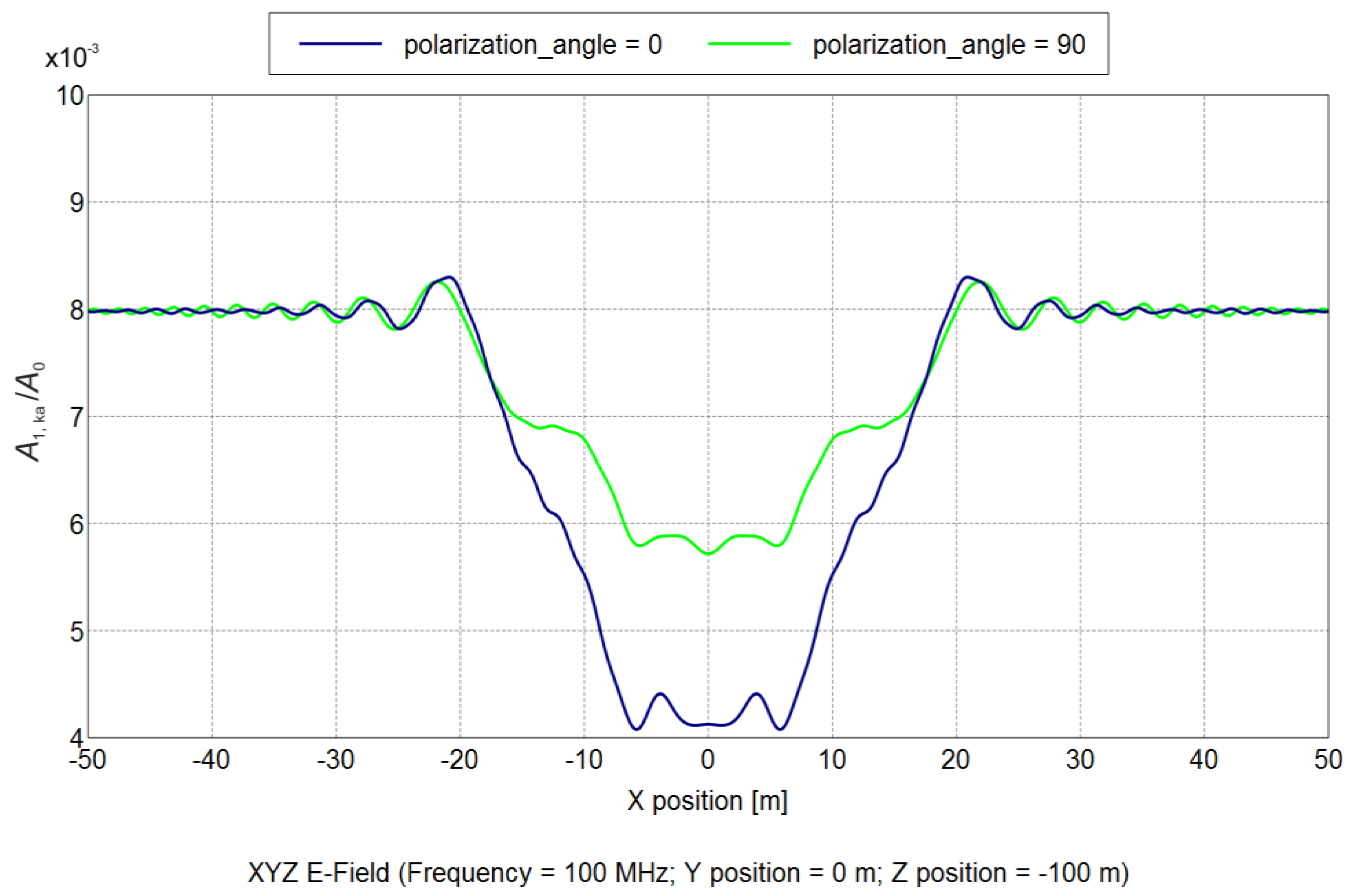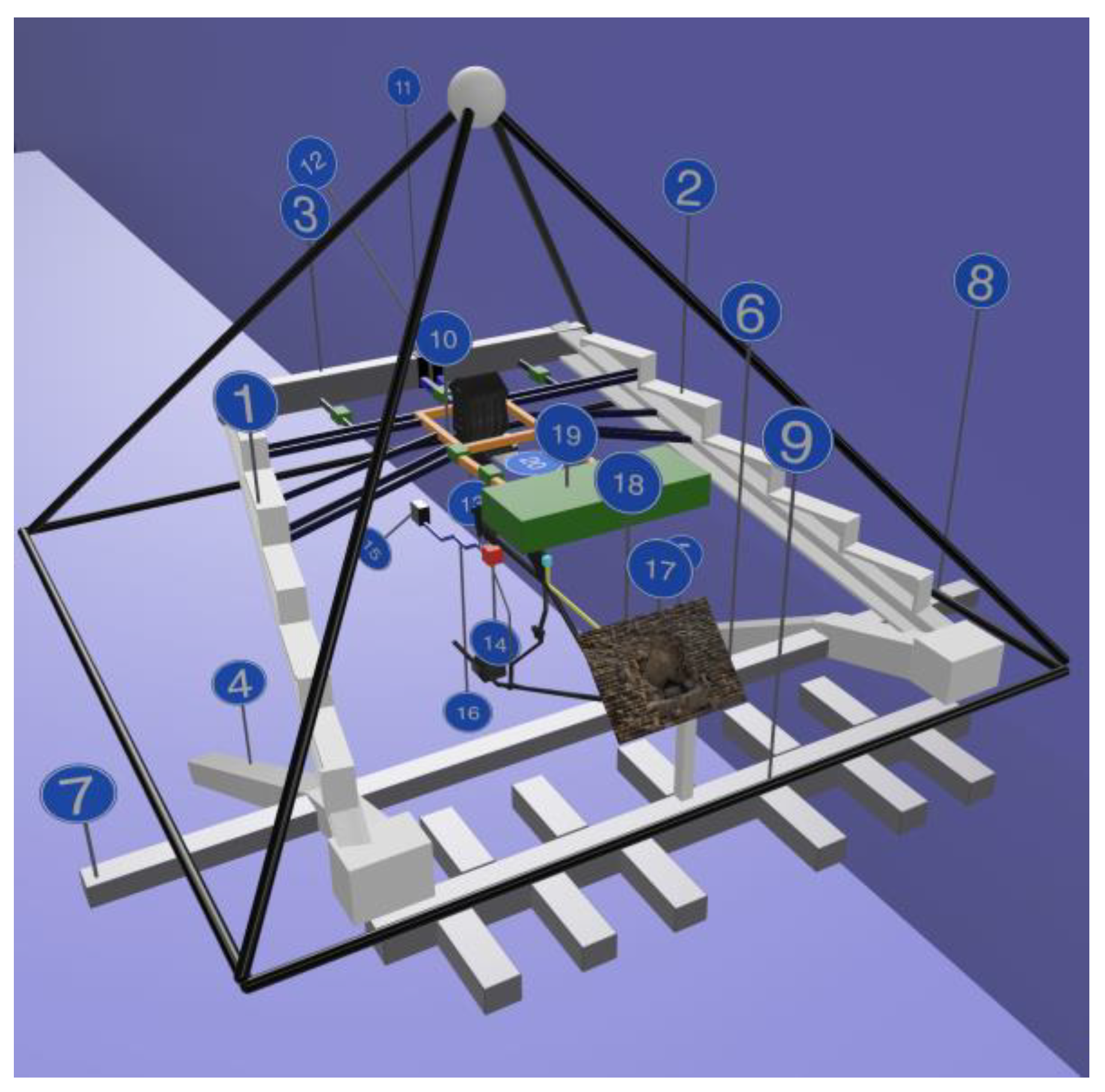1. Introduction
The architectural objects of antiquity, especially the pyramids, attract the attention of scientists because many details of their construction, assignment and features of their internal structure are still unclear. The most famous such objects are the pyramids on the Giza plateau in Egypt, the Mayan pyramids on the Yucatan Peninsula in Mexico, the pyramids of Cambodia and the pyramids of Güímar in the Canary Islands. The construction of pyramids is characteristic of many antique civilizations, even those undeveloped in comparison with ancient Egypt [
1].
Undoubtedly, the Great Pyramid of Giza is of the supreme interest as a monument built by a long-vanished ancient civilization that left a noticeable mark on the history of humankind [
2,
3]. This Pyramid is also called by the name of its creator Pharaoh Cheops-Khufu. The first name came to us from the old Greek authors, and the second from the Egyptian papyri after the ancient Egyptian letters were deciphered much later.
The Pyramid construction was ended probably in 2540 BC, i.e., it is over 4500 years old now. The Great Pyramid is the tallest and most massive architectural object of antiquity and has attracted the attention of historians, researchers and robbers of all kinds since ancient times. The ancient Greeks considered the Great Pyramid to be one of the wonders of the world. Amazingly, for more than three millennia (before the construction of the cathedral in Lincoln, UK, c. 1300), the pyramid was the tallest building on Earth.
The Pyramid is built of massive stone blocks, mostly limestone but there are granite blocks also. The weight of some blocks reaches tens of tons [
3]. This circumstance saved the Great Pyramid from robbers, who plundered most of the tombs in ancient times, especially in the Valley of the Kings, because they were more accessible. To penetrate the Great Pyramid, organization not available to ordinary robbers and bandits was required.
The first, who tried to get inside the Great Pyramid, seems to have been Abu al-Abbas Abdallah ibn Harun al-Rashid (better known by his regnal name Al-Ma’mun). He was the caliph of Baghdad, and was also known as a scientist and an astronomer. However, his methods of ruling were quite consistent with his era. Al-Ma’mun ordered in 831 to open the Pyramid of Cheops-Khufu. Given the level of technology of that time, it was possible to penetrate inside the Pyramid only by destroying part of it. After several unsuccessful attempts, the entrance to the Grand Gallery was found. The caliph was most likely the first person who entered the pyramid after its construction. To his anger, nothing was found inside the Pyramid other than a thick layer of dust and an empty granite sarcophagus with shifted lid. All other interior spaces within the Great Pyramid available to him at that time were found empty. Now this entrance to the Pyramid has turned into a tourist attraction.
Since Al-Ma’mun’s time, there have been assumptions that there must be some still unknown internal rooms where the Khufu mummy and burial objects including jewelry are hidden. This assumption is substantiated by the conclusion that such a majestic structure, which was worth a lot of money, effort and time for its construction, could not be left empty. Moreover, the Khufu mummy has not been discovered so far.
Interest in archaeological research was fueled by the great discoveries made Johann Schliemann in 1873 and Howard Carter in 1922. The first unearthed Troy, which was known only in the Homer legends and the second found the unplundered tomb of Tutankhamun in the Valley of the Kings. However, to survey the Great Pyramid, other non-destructive testing (NDT) technology were needed, which appeared by the middle of the 20th century. The description of these capabilities is the subject of this article.
The next four sections discuss in succession the potentialities, limitations and achievements of NDT technologies based on the detection of muon elementary particles, gravitational measurements, the study of radio wave propagation, and vibration registration.
2. Cosmic Ray Muon Detectors
The Pyramids of Giza are too massive structures for using the conventional X-ray technology, which has found wide application in medicine and some fields of engineering, due to the high level of absorption for this kind of emission. For the same reason, different types of tomography cannot be used. A type of radiation is required that can propagate in the substance of the pyramids at distances comparable to their sizes, i.e., a few hundred meters.
This candidate turned out to be elementary particles muons, which are produced in large numbers as a result of the impact of high-energy cosmic particles with air molecules in the Earth’s atmosphere. The muon is similar to the electron, with an electric charge of −1 e and a spin of 1/2, but with a much greater mass of 207 times that of the electron. Muons have a sufficient lifetime of 15 μs. Muon decay almost always produces at least three particles, which must include an electron of the same charge as the muon and two types of neutrinos. Due to their high mass, the mean free path of muons, depending on the density of matter, ranges from several hundred meters to a few kilometers.
The first to propose the use of cosmic muon fluxes for transilluminating the internal structure of the Egypt pyramids was an American experimental physicist and Nobel Prize winner for 1968 Luis W. Alvarez [
4]. He also noted that detectors of elementary particles are able to register the direction from which the particle arrived. This property is important for determining possible inhomogeneities within the object under investigation. Analyzing the flux density and the direction of muon motion, as well as solving the inverse problem, it is possible to establish the distribution of the density of matter in different directions [
5]. This allows us to make reasonable assumptions about the presence of voids in the body of the pyramid.
In the 60’s of the last century L.W. Alvarez using spark chambers for detecting muons had done research inside the Chephren’s Pyramid,
Figure 1. The Chephren’s Pyramid is the second in dimensions and only slightly less than the pyramid of his father Cheops-Khufu.
However, Alvarez and his team failed to find anything interesting and significant [
4]. Perhaps this was due to the shortcomings of the experimental technique of those times. Currently, spark cameras are considered obsolete and are museum exhibits.
The next step was taken recently by an international team led by a group of Japanese researchers at a new technical level using modern muon detectors. This project was called ScanPyramids. The set of equipment in the project included gas detectors, nuclear emulsion films and scintillator hodoscopes. By placing muon sensors both inside the Great Pyramid and outside it, it was possible, presumably, to detect two previously unknown cavities—Big and Small voids,
Figure 2 [
6].
According to the results of the ScanPyramids project it is possible to assume that the Big void has a fairly large volume, comparable to the volume of the Grand gallery, and is located deeply enough in the body of the Pyramid, while the Small void is located relatively close to its surface [
6].
The last suggestion regarding the Small void has recently been confirmed by sensors operating on other physical principles. Using a multi-frequency (200, 400 and 600 MHz) Ground-Penetrating Radar (GPR) and Ultrasonic Testing (UST) transducer, which works at a center frequency of 40 kHz, a void was found behind a very conspicuous spot on the Pyramid surface. It is the so-called the Chevron [
7]. This place itself, in its appearance, suggests the possibility that behind it there is a hidden entrance to the Pyramid,
Figure 3. The use of GPR and UST was justified by the fact that the void was placed close enough to the surface of the Pyramid.
Processing of the received echoes confirmed that there may be a previously unknown void or room behind the Chevron. Researchers from Cairo University and the Technical University of Munich used endoscopy to confirm this suggestion. They managed to find gaps between the blocks of the Pyramid into which the endoscopy was inserted. The resulting image amazed them,
Figure 4 [
8]. The far end of the discovered room is sealed and may represent a door leading into the depths of the Pyramid.
This sensational discovery is important because it confirms the correctness of the conclusions of the ScanPyramids project at least in part of one of the predicted, i.e., the Small void. However, the Big Void lies deeply within the body of the Great Pyramid, and other methods and technologies will be required to locate it.
Although muon technology can still be improved and such proposals already exist [
9], other independent non-destructive testing methods for examining the internal structure of the Giza pyramids are also desirable to confirm conclusions of the muon projects. The following sections of this article are devoted to the discussion of such possibilities.
3. Microgravimeter Measurements for Finding Anomalies
Microgravimetry can turn out to be such a method among with others. It should be noted that the idea of using gravitational measurements in archeology is not completely new. Thus, gravimetric survey for the study of archaeological objects has already found its application in some cases [
10,
11]. There were also fruitless attempts in 1986–1987 with the support of the largest French company for the operation of nuclear power plants EDF to use gravimetry for surveying the Great Pyramid [
12,
13,
14].
Measurements of the gravitational field were carried out only inside the Pyramid. A small gravity anomaly of 30 microgals (1 microgal = 10
−8 m/s
2) in the corridor leading to the Queen’s Chamber was detected [
14]. At that time, it was possible to obtain permission from the Egyptian authorities for drilling. To the disappointment of the researchers, the drill fell into a cavity with quartz sand after 3 m. Additionally, since the information got into the press, the drilling took place in the presence of a crowd of journalists of approximately 50 people. Publicity and general disappointment led for many years to the termination of the entire gravitational project [
14]. However, the muon ScanPyramid project and its discoveries [
6] give hope and have returned attention to alternative methods of surveying the Giza Pyramids, including gravitational measurements [
15].
The parameters of previously unknown voids predicted in the muon project allow us to make some estimates regarding the possibility of using modern microgravimeters to detect them mostly as example for the Big void. In contrast to previous studies, we will evaluate the achievable measurement parameters along the outer surface of the Cheops Pyramid.
The main property of the gravitational field, which is of interest for the purposes of this project, is its ability to propagate without attenuation in matter. Gravity cannot be shielded or weakened in one way or another. The intensity of the gravitational field depends only on distribution of the mass of the substance and the distance to the measurement point. After correcting for centrifugal forces resulting from the Earth’s rotation, an equation for gravitational force
can be written as [
16]
where
G is the gravitational constant,
μ the unit mass,
dm the earth mass element,
;
are radius vectors of the measurement point and mass element,
ω is the angular velocity of the earth’s rotation; the integral is taken over all masses
M. It is more convenient to transform the equation into a form in which the integral over mass is replaced by integration over volume
, where
—density of matter at a given point in space,
—volume element, and force
is replaced on acceleration
g. Then, (1) can be transformed to the form
Thus, if the mass in the considered volume has a variable density, this affects the force of gravity and, consequently, the value of the free fall acceleration becomes equal to g0 + Δg. Here, g0 is the standard free fall acceleration at the Earth level, and Δg is the change in this value caused by the presence of subsurface inhomogeneities. The gravitational acceleration depends on the latitude at which it is measured. It is greater at the poles of the Earth, and less at the equator due to the centrifugal forces caused by its rotation. Usually, the value of g0 at the equator at sea level is taken as the standard value g0 = 9.81 m/c2.
The effect of variable measured g has long been used in geophysics and geology, for example, to detect ore bodies under the earth’s surface, which may have a substance density different from the surrounding space containing them, as well as to detect cavities, such as tunnels or karst voids [
17]. An illustration of this effect is shown in
Figure 5.
To assess the possibility of cavities detection inside the Pyramid, let us simplify the task as much as possible. Let us neglect the influence of the Earth’s rotation in (2), the tidal forces of the Moon and the Sun, and other similar factors. Of course, they are important in the processing of measurement results, but they are insignificant in assessing the capabilities of modern gravimeters for solving the problem under consideration.
Figure 6 shows three options for calculating the integral (2):
- (a)
A homogeneous half-space with a density of ρ0. Here, the assumed cavity with volume of VM has the same density of matter as the space containing it and mass of M. In this case, the gravitational acceleration force on the surface is equal to g0. So that g0 does not become equal to infinity, the half-space can be limited to a layer of finite thickness. The thickness of the layer does not matter for our estimates.
- (b)
The same layer with arbitrarily shaped void (ρ = 0 and zero mass) and the same volume VM. Now the acceleration force over the void at some central point is equal to g = g0 − Δg.
- (c)
The void has the same shape, but is filled with matter with a density of ρ0, and the density of the layer is zero.
Obviously, the sum of the integrals for cases (b) and (c) is equal to
g0. Therefore, the acceleration calculated for case (c) is equal to Δ
g. Let us make one more simplification that the object of mass
M = ρ0VM has the shape of a sphere. Then, the gravitational field generated by it in the surrounding space is equal to the gravitational field of the equivalent mass, but concentrated in the center of the sphere. Then, the force acting on a unit mass on the surface is [
15]
where
L is the distance from the center of the sphere to a point on the surface of the imaginary layer. This equation will always be valid for the case
L >> l, where l is character dimension of the void. The Relation (3) is also intuitive understandable and easily proved by the dimensional analysis [
18,
19] because there is single combination of task parameters
ρ0,
VM,
L and
G that has dimension of acceleration
g.
There are only assumptions regarding real size of the Big void in the Great Pyramid discovered during the ScanPyramids project. It was assumed in [
6,
20] that the length of this void is at least 30 m long and has the cross section similar to the Great Gallery of the Pyramid, i.e., 2 × 8 m
2. At these assumptions the volume of the Big void will be approximately 480 m
3. The main part of the Pyramid’s blocks consists from crystalline limestone that has density of
ρl = 2800 kg/m
3. Taking into account this parameter, the mass
M in (3), which is equivalent to the mass of limestone that could fill the volume of the Big void, is equal to 1.34 · 10
6 kg.
Let us evaluate the effect of such a mass at a distance of 10, 25, 50, and 100 m. The value of the gravitational constant is
G = 6.67 · 10
−11 m
3kg
−1s
−2. Given that the force was calculated for a unit mass of 1 kg, the acceleration Δ
g generated by this force in the measurement unit 1 Gal = 1 cm/s
2 is shown in
Table 1.
For comparison, the standard gravitational acceleration in these units is
g0 = 981 Gal. Thus, the assessments made show that a microgravimeter with a sensitivity of at least 10
−7 ÷ 10
−6 Gal is needed to survey the Great Pyramid. By measuring the deviation of the gravitational field on the Pyramid surface at taking into account the free-air correction [
21] and than solving the inverse problem [
22], it is possible to establish the mass distribution inside the pyramid [
23,
24]. The solution of the inverse problem is facilitated by the possibility of accessing to the interior of the Pyramid. It then becomes possible to carry out measurements not only on the surface of the Pyramid, but also inside it. Measurements of the gravitational field inside the Great Pyramid will provide additional data and improve convergence when solving the inverse problem. The geometry of the Khufu’s Pyramid, including its inner part, is well known,
Figure 1 and [
25]. This gives hope to resolve the inverse problem with rather better accuracy. This would confirm or disprove the discoveries that were made in the ScanPyramids project by muon detectors.
The task of determining the gravitational field on the surface of the Pyramid with the required accuracy is rather difficult. Perhaps it is simpler than the detection of gravitational waves [
26], but it will also require considerable efforts and time. Modern microgravimeters, which are using in geology to find ore deposits [
27], can be divided into two main categories: absolute gravimeters and relative ones. Absolute gravimeters determine the absolute values of the gravitational acceleration by direct measuring the acceleration of a freely falling body. Relative gravimeters can measure only acceleration changes regarding to some level. Absolute gravimeters are much more cumbersome and have lower accuracy than relative ones [
28], and they are not suitable for solving the problem under consideration.
The Scintrex CG-5 relative gravimeter is one of the best gravimeters of its type. It has a sensitivity of 10
−7 Gal with a signal accumulation time of 5 min [
28,
29]. This, according to the data given in
Table 1, will apparently be sufficient to solve the problem. The gravimeter has a moderate weight of approximately 8 kg and dimensions of 30 cm (h) × 21 cm × 22 cm [
30].
To determine the approximate dimensions and position of the Big void of the Great Pyramid, a resolution of 5–10 m is required. The area of the four faces of the pyramid for its modern size is approximately 83 · 10
3 m
2. Thus, if measurements of the gravitational field are made with steps of 10 m, approximately a thousand measurements may be required, and if after 5 m then, respectively, four times more. Since one measurement with the CG-5 gravimeter requires 5 min, and moving the device to a new location and setting it up requires at least 15 min, the total time of continuous operation can be approximately 300 h. Of course, you can use several devices but in any case the time to perform measurements will be quite large. The complexity and duration of the gravity project are comparable to the ScanPyramid muon project [
6].
A device that could automate the measurements and reduce the use of manual labor is to apply unmanned aerial vehicle (UAV) to deliver the gravimeter to the desired point on the step surface of the Pyramid. Unfortunately, modern quadrocopters with a payload of 10 kg are not capable of landing on a narrow platform of half meter wide due to their size. In addition the gravimeter, which is once delivered to the measurement site, needs alignment and leveling, which is currently done manually. The use of UAV in this project is very tempting but needs further study as it is not excluded possibility development of a specialized UAV capable of landing on a stepped surface, taking into account the width and height of the Pyramid’s steps.
4. Evaluation Possibility of Using the Radio Frequency Range for the Survey of the Great Pyramid
Another of the tools, which has found wide application in recent years, including archeology, are GPR operating in the microwave (MW) and radio frequency (RF) range [
31,
32]. The idea to use radio waves for study of the Egypt Pyramids is well known [
33,
34,
35]. Initially it was proposed that pyramids’ stones are almost dry because of low humidity on the Giza deserty plateau. Moreover, the plateau is much higher than that of the Nile, of ground water. So it was possible to penetrate inside the bodies of pyramids by electromagnetic waves of radio frequency range because of the low level of attenuation. An important feature of electromagnetic waves compared to acoustic waves is also their ability to overcome cracks and gaps between pyramid stone blocks, whose dimensions are smaller than the wavelength, with virtually no loss.
It is also worth mentioning a recent attempt to evaluate radio waves for non-destructive investigation of Egyptian pyramids [
36]. Following a literature review of different methods used in examining cultural objects, it seems that is also possible to apply this technology for detecting voids or other unknown structures of interest to archaeologists/Egyptologists and the public.
Based on the analysis of possible electromagnetic properties of the Pyramid, a simple model was proposed,
Figure 7 [
36], that allowed evaluation of the possibility of detecting voids in the Great Pyramid using electromagnetic radiation at frequency
f = 100 MHz corresponding to a wavelength in air of approximately 3 m. Therefore, to preliminarily assess the feasibility of scanning the Pyramid, instead of the exact dimensions of Khufu’s Pyramid, the calculations used an infinite dielectric layer of thickness
L = 100 m corresponding to the width of the Pyramid edge at the height of the Big void according the muon experiment data,
Figure 2.
For simplicity, the void was approximated by an ellipsoid of revolution, the dimensions of the axes d and D of which were 5 and 30 m, respectively. The volume of such ellipsoid approximately corresponded to the volume of the Grand gallery of the Pyramid. During the calculations, two cases were analyzed: Case 1, it is shown in
Figure 7, when the major axis of the ellipsoid was parallel to direction of the incident electromagnetic wave, and Case 2, when the axis was perpendicular.
Since the Great Pyramid consists mainly of limestone, real part of dielectric constant
εr was set to 7 at
f of 100 MHz [
37]. For this f and
εr, the signal wavelength in limestone is approximately 1.1 m, which is less than the characteristic sizes of voids (chambers and galleries) already known in the Pyramid. It can be expected that the Big void presumably discovered by the muon experiment have larger dimensions.
The most important parameter affecting the possibility of examining the Pyramid is the level of attenuation ka of electromagnetic waves in limestone. The value of this parameter becomes clear taking into account the distances that the probing signal must overcome in matter of the Pyramid, i.e., 100 or more meters. This issue requires special consideration and will be discussed later.
Calculations were carried out according to the chosen model and for a low level of attenuation
ka = 1.0 dB/m.
Figure 8 shows a comparison of the recorded signal for two positions of the void relative to the direction of the probed signal. It can be seen that the position of the cavity dramatically affects the shape of the recorded signal.
Figure 9 represents the influence of the polarization direction on form and amplitude of recorded signals for Case 2. Polarization angle of the electromagnetic wave is counted from the major axis of the ellipsoid. As seen from this figure, at polarization angle of 0°, i.e., parallel polarization, the recorded signal is noticeably stronger than at perpendicular one at angle of 90°. This effect could give additional information about internal objects in the pyramid. It is obvious that in Case 1, the influence of wave polarization is absent because of the symmetry of the task.
The calculations have shown that the signal attenuation level for various values of the parameter ka almost does not influence on form if recorded signal, but certainly influences on its amplitude and is inverse proportional to ka.
The level of signal attenuation in the pyramid body is crucial for solving the problem. Estimates were made of the possible values for the attenuation coefficient at which reception of radio waves passing through the pyramid would be possible considering the intrinsic noise of the transceiver system, as well as external electromagnetic noise. At attenuation level more than 2.0 dB/m, the registration of a useful signal for such massive object as the Great Pyramid is hardly feasible [
36].
Khufu’s Pyramid consists of mainly limestone blocks and with a few granite inclusions. It was reported [
3,
38] that, according to various estimates, out of 5.5 million tons of the total weight of the Pyramid only 8 thousand tons are granite blocks (i.e., granite is only 0.15% of the mass). This is understandable since granite is much harder to process than limestone. Since the Pyramid was built during the Bronze Age, it was a difficult task for builders procure granite blocks of 40 tons–50 tons (according to other estimates 25 tons–80 tons) from the quarry near Aswan (800 km upstream on the Nile). One such granite block (apparently the largest known) is placed above the entrance to the King’s chamber.
The dielectric properties for dry granite and limestone according to [
33,
35,
37,
38,
39,
40] are shown in
Table 2. Note that the relative permittivity (
εr) data range from 4 through 10, but attenuation varies widely (by a factor of 50) from 0.5 to 25 dB/m. The level of attenuation as this was mentioned before is critical for evaluating the feasibility of electromagnetic imaging because high attenuation could prevent transmission of a recordable signal along the required path length (whether a one-way path for two-sided imaging, or two-way for one-sided methods). Although
Table 2 lists properties for granite and natural limestone, there is evidence for a controversial proposition (based on scanning and transmission electron microscopy and geochemical analysis) that many of the “limestone” blocks are reconstituted—essentially an ancient and astoundingly realistic and durable concrete [
38].
The large scatter in the data in
Table 2 concerning attenuation presented in these papers is primarily due to the fact that the attenuation level is determined by humidity. Water itself is an abnormal liquid with a high dielectric constant, but as it seeps into a natural material and dissolves the salts forming an electrolyte this leads to increasing the attenuation of electromagnetic waves. Wherein, with an increase in the moisture content in the material, the attenuation level also increases [
41].
Both of these factors—humidity and salinity—create significant uncertainty in determining the level of attenuation of electromagnetic waves when it comes to direct measurements in the Pyramid. Here, one cannot rely only on laboratory measurements in vitro or literature data. Measurements are required to be directly on the Pyramid in situ.
Earlier it was indicated that the survey of the Great Pyramid in the radio range frequencies was undertaken in the 1970s [
33] and 1980s [
34] of the last century by independent groups of researchers from the USA and Japan. Both attempts were unsuccessful because of failing to register either the transmission signal or the reflected signal. As a result, it was not possible to measure the level of attenuation.
This gave rise to the many already existing mysteries regarding the structure and purpose of the Great Pyramid, two more that require their explanation and further research.
Firstly, the level of humidity, which was measured inside the Pyramid, was very high approximately −80% [
33]. The authors proposed two hypotheses as explanation: high humidity of the wind from Mediterranean and numerous flux of tourists inside the Great Pyramid, and their breathing increase humidity inside. The last assumption is not entirely justified, because of high humidity is also observed in other pyramids of Giza, in which tourists are not allowed.
Secondly, when Caliph Al-Ma’mun made the first entry into the Great Pyramid in 831 CE, he reported that the chambers were “mysteriously encrusted with salt as much as one-half inch thick” [
33]. It is possible to suggest that salt permeate with ionic water from below rocks. If this is true, why only in the Pyramid, but not the surrounding native surface stones? Or perhaps the salts are leached from the Pyramid blocks?
In conclusion to this section, we would like to add that the determination of the electrical properties of the stone blocks that make up the Great Pyramid is an important independent task for understanding its structure, history, and the possibility of preservation for future generations.
5. Elastic Waves and Vibrations as a Means of Non-Destructive Testing
One of the most commonly used means of non-destructive testing, along with X-rays, is ultrasonic technology. Ultrasonic waves are elastic oscillations that can propagate in material media. The main property of these waves, which are longitudinal oscillations of matter, is the possibility of propagation with a sufficiently low level of attenuation, depending on the properties of the medium, over long distances. In solids, transverse waves associated with shear oscillations can also arise.
The main requirement for a medium, in which elastic oscillations can propagate, is its continuity [
42]. Such continuous media include: gases (including air), various liquids, cast metals, bedrock of the Earth and other similar media. When interacting with a local heterogeneity in such media, elastic waves are scattered and reflected that can be recorded by instruments. Depending on the frequency range, these waves are called sonic (or sound) waves, perceived by the human ear in the range from 15 Hz to 20 kHz, or ultrasonic for higher frequencies. In particular, UST transducer with an operating frequency of 25 kHz, along with GPR, have already been used in the detection of the Small Void of the Pyramid [
7,
8] predicted from the results of the muon experiment [
6].
The main disadvantage that prevents the use of acoustic and ultrasonic technologies in comparison with electromagnetic waves is the requirement for the continuity of the medium, since the presence of cracks or slots leads to almost complete reflection of such waves on them. In this regard, electromagnetic waves have an undeniable advantage, because for them, the presence of medium discontinuities with a thickness much smaller than the wavelength is not an obstacle, and their scattering occurs only on heterogeneity, whose dimensions exceed the wavelength. In this regard, the pyramids of Giza, built from separate blocks, are a complex structure in which the propagation of elastic waves will be subject to numerous reflections and high attenuation. However, undoubtedly, ultrasonic devices can be used to diagnose individual stone blocks, as was done in [
7].
Lower frequencies in relation to sonic ones are vibrations. They are characterized by the oscillation of the body as a whole, i.e., when the wavelength of oscillations is greater than the characteristic size of the system under consideration. The possibility of using vibrations, which produce micro-motion (MM) of the surface body, for studying of the internal structure of the Pyramid is being explored in [
43]. Although the paper contains some controversial statements regarding the timing and methods of the Pyramid construction, the idea of using the MM measurements of the Pyramid surface, the origin of which is associated with micro-earthquakes and other factors (wind load and the proximity of the suburbs of Cairo, which are literally adjacent to the Giza plateau), deserves attention. The authors proposed using satellite Synthetic Aperture Radar (SAR) for determining Doppler frequency shift that is induced by micro-motion at reflection of electromagnetic wave from moving surface.
The measurement of vibrations, which generate the Doppler frequency shift of the reflected electromagnetic wave, has previously given rise to numerous areas of application and process research, such as the detection and remote diagnostics of people, including behind obstacles [
44], humanitarian demining [
45], the study of volcanic and seismic activity [
46], as well as many others. Based on the results of measuring the surface vibration of the Great Pyramid, the authors of paper [
43] describe the location of already known objects inside it, such as the chambers of the King and Queen, a Large Gallery, but also predict the existence of internal ramps,
Figure 10. These ramps, according to one theory of the construction of the Pyramid, were used to deliver blocks of limestone and granite to the upper layers as its height increased.
The very idea of the vibrations measurement of architectural structures not only of antiquity, but also of modernity by radars, although not new [
47,
48] certainly could be used in line with other NDT technologies. It is possible to propose development of this method. Vibrations could be excited artificially [
49] with a known frequency and shape at some distance from the structure, and their amplitude can be sufficiently small so do not pose a threat the integrity of the structure under study. The use of artificially induced vibrations will make it possible to study the frequency characteristics of the object under consideration. Registration of vibrations can be carried out both directly on the surface of the structure by vibrometers or remotely by using laser and radar technology.
6. Conclusions
This paper considers the most relevant non-destructive methods of surveying the Great Pyramid on the Giza plateau in Egypt, which were proposed and used since the middle of the last century. These include muon detectors, radar of meter-range, gravimeters and vibration measurement based on the results of satellite radar measurements.
From the above review, it follows that muon detectors have turned out to be the most successful means of diagnosing the Pyramid, although this does not exclude the use of other technologies considered. Moreover, given that modern provisions for the conservation of cultural heritage of humankind practically exclude the possibility of using destructive methods such as making passages or even drilling small wells, an integrated approach is needed using various non-destructive diagnostic methods. This will avoid erroneous discoveries, which are always possible when using indirect non-invasive diagnostic methods.
When considering the issue, other fundamentally possible means of non-destructive diagnostics were not touched upon, for example, X-ray or neutrino sensors. The first is due to the large size of the Pyramid, which exceeds the capabilities of modern X-ray technology by several orders of magnitude, and the second is due to the extremely low sensitivity of neutrino detectors, which, even when measuring the huge fluxes of solar neutrinos, allow to register only a few events per year.
In conclusion, people have created the most beautiful mathematical apparatus of quantum mechanics and have learned to register gravitational waves, but it should be noted with regret that even the use of all the power of modern science does not allow us to explain all the mysteries of the structure created by the ancient civilization more than four and a half millennia ago.
